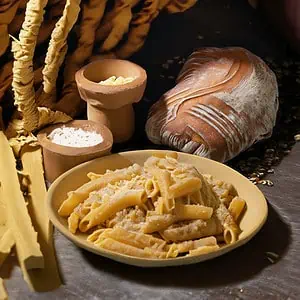Neanderthals and Proto-Europeans now confirmed Bakers at over 40,000 years ago
You can now watch our companion video on Neanderthals and Proto-Europeans first to produce flour at our YouTube channel.
 Neanderthals it now appears may have been making flour at the same time as Homo sapiens in Europe, maybe even before the newcomers arrived.
Neanderthals it now appears may have been making flour at the same time as Homo sapiens in Europe, maybe even before the newcomers arrived.
Previously it was believed that the mysterious Natufian people, who lived in what is modern day Israel and Jordan, were the first to produce flour-based foods, 14,000 years ago. And there are some indications that the Natufians even brewed beer.
From Archaeology.org, January 2019,
“The First Bakers”
About 14,400 years ago in the Black Desert of northeastern Jordan, someone was tinkering with the recipe for the perfect pita. This auspicious moment in culinary history has been captured by researchers who sampled the contents of two stone fireplaces at the site of Shubayqa.
The team, led by University of Copenhagen archaeobotanist Amaia Arranz-Otaegui, found that the people living at this small campsite, hunter-gatherers who belonged to a culture known as the Natufians, were making unleavened bread-like products at least 4,000 years before the dawn of agriculture.
Bread and possibly beer, produced from wild plants before the origins of Agriculture
 The team found charred remains that appeared to be flour-based products. Amazingly, Arranz-Otaegui was collecting what appeared to be little black rocks at a Natufian camp fire site. They turned out to be bread crumbs.
The team found charred remains that appeared to be flour-based products. Amazingly, Arranz-Otaegui was collecting what appeared to be little black rocks at a Natufian camp fire site. They turned out to be bread crumbs.
Analysis at the laboratory proved their hunches to be correct. The lead researcher is quoted as saying:
“We were very surprised to find bread made before the origins of agriculture. Archaeologists have tended to ignore food remains that we don’t recognize, and I’m sure the remains of bread-like products even more ancient than these are everywhere.”
Breaking news out of Quebec media…
From Radio Canada, July 2:
 Des traces de végétaux sur des pilons préhistoriques découverts en Italie permettent de faire reculer l’apparition des techniques de fabrication des farines par les humains. Julien Riel-Salvatore décrit à Sophie-Andrée Blondin les travaux qu’il a menés avec son équipe pour prouver qu’il y a 43 000 ans, pendant la transition entre Néandertal et Sapiens, les deux espèces maîtrisaient des techniques pour moudre des grains.
Des traces de végétaux sur des pilons préhistoriques découverts en Italie permettent de faire reculer l’apparition des techniques de fabrication des farines par les humains. Julien Riel-Salvatore décrit à Sophie-Andrée Blondin les travaux qu’il a menés avec son équipe pour prouver qu’il y a 43 000 ans, pendant la transition entre Néandertal et Sapiens, les deux espèces maîtrisaient des techniques pour moudre des grains.
[Translation mine] Traces of plants in the prehistoric pilons (hammer-like masher) discovered in Italy appear to indicate flour making techniques by humans. Julien Riel-Salvatore describes to Sophie-Andree Blondin the work by he and his team conducted to show that 43,000 years ago during the transition between Neanderthals and [Homo] sapiens, both species mastered the techniques for pounding the grains.
A paper has just dropped at Science Direct, dated July 15, 2023,
New evidence of plant food processing in Italy before 40ka
Authors include Riel-Salvatore, Mariotti Lippi and 10 other Italian authors.
From the Abstract:
 Evidence of plant food processing is a significant indicator of the human ability to exploit environmental resources. The recovery of starch grains associated with use-wear on Palaeolithic grinding tools offers proof of a specific technology for making flour among Pleistocene hunter-gatherers. Here we present the analysis of five grindstones from two Italian sites, Riparo Bombrini and Grotta di Castelcivita, both inhabited during a crucial phase spanning the decline of the Neanderthals and the establishment of Sapiens.
Evidence of plant food processing is a significant indicator of the human ability to exploit environmental resources. The recovery of starch grains associated with use-wear on Palaeolithic grinding tools offers proof of a specific technology for making flour among Pleistocene hunter-gatherers. Here we present the analysis of five grindstones from two Italian sites, Riparo Bombrini and Grotta di Castelcivita, both inhabited during a crucial phase spanning the decline of the Neanderthals and the establishment of Sapiens.
The authors of the study seem to suggest that Neanderthals actually produced flour prior to Homo sapiens. That opens up the possibility for joint cooperation between the two species, and the likelihood of Neanderthals teaching the Homo sapiens flour production.
Neanderthals not only consumed and processed plants but also made flour 43–41,000 years ago.
Additionally:
Starch grains attributable to Triticeae on Protoaurignacian grindstones at both sites testify that Sapiens were processing wild cereals at least 41,500–36,500 years ago when they expanded into Eurasia, long before the dawn of agriculture.
Riel Salvatore also notes that the ability to produce bread and other flour products would have greatly helped early Homo sapiens to travel to other parts of Eurasia.



None of this is surprising. Processing and preserving plants came shortly after hominins started eating them, which was a lonnnnnng time ago. Like in millions of years. . . .
What made the late human “agricultural revolution” special wasn’t its diet, it was that the bounty was distributed by social network requiring roles, complex planning, institution, and infrastructure.
Duncan, have you seen my YouTube video on this? I hope you watch my YouTube channel too.
And please leave comments over there.
https://www.youtube.com/watch?v=PF120H_f8iU&t=4s